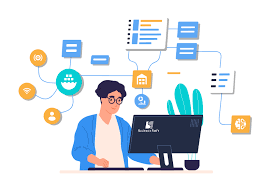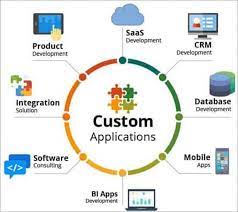Custom Software Applications and Website
There are numerous tasks involved in developing custom software applications and websites, and while some are straightforward, others require deeper thought and consideration. In general, these tasks fall into three categories: preparation, development and deployment, and testing/verification.
The design of a custom application or website requires a thorough understanding of the client’s functional requirements, technical constraints, and the user experience (UX) goals.

Most Important Steps in Custom Software and Website
1. Preparation
Depending on the project’s scope and goals, several preliminary decisions must be made. At a minimum, for effective planning, gather the following information ahead of time:
- A comprehensive list of functional and technical requirements for each user group or system component.
- Mockups or wireframes to visualize the user interface and user experience.
- Technical architecture, including hosting environments, frameworks, and third-party integrations.
- A detailed sitemap or workflow of the application, outlining core features and navigation.
- Estimated timelines for each development phase and milestones.
- Cost estimates and budget allocation for development, testing, and deployment.
- Regulatory compliance requirements, such as GDPR or ADA accessibility standards.
- A verified list of deliverables agreed upon with the client or stakeholders.
Once all the above data is compiled, you can create a project roadmap. The most intricate part of this stage involves aligning technical feasibility with business goals and ensuring scalability of the system. Tools like prototyping software and project management platforms can streamline this process, but experienced project managers and developers are essential to maximize efficiency.
2. Development and Deployment
Once the preparation phase is completed, the project plan is finalized, and the team is equipped, development can begin. The primary components involved in this phase include:
- Frontend Development: Coding the user-facing side of the application or website, ensuring it is intuitive, responsive, and visually appealing.
- Backend Development: Setting up servers, databases, and APIs to handle the application’s logic and data processing.
- Integration: Connecting third-party tools, APIs, and services to extend the system’s functionality.

Standard activities during this phase include:
Version Control and Collaboration
- Use tools like Git to maintain a record of code changes and facilitate team collaboration.
- Establish branching strategies to manage new features and bug fixes.
Code Quality and Optimization
- Conduct regular code reviews to maintain standards and improve performance.
- Optimize for fast load times and ensure the application works on various devices and browsers.
Security Implementation
- Implement authentication and authorization protocols.
- Use HTTPS, encrypt sensitive data, and follow best practices to prevent vulnerabilities.
3. Testing and Verification
To ensure a high-quality product, thorough testing and verification are critical. The goal is to deliver an application or website that meets all functional requirements and performs optimally under various conditions.
Key Testing Activities:
- Unit Testing: Verify that individual components function as intended.
- Integration Testing: Ensure seamless communication between different modules and external systems.
- User Acceptance Testing (UAT): Validate that the application meets client and user expectations.
Be Sure To:
- Verify cross-browser compatibility and responsive design on multiple devices.
- Conduct load testing to ensure the system performs well under expected traffic.
- Ensure compliance with any regulatory or industry standards.
Be Sure Not To:
- Overlook edge cases in testing, which could lead to errors in uncommon scenarios.
- Ignore user feedback collected during UAT or beta testing phases.
- Deploy without creating a rollback plan in case of critical issues.

If you’d like to contact us and get in touch with us requesting any of our services, or quotations you can do so by phone, email or by post. If you email us, we’ll always contact you within 1 working day.
